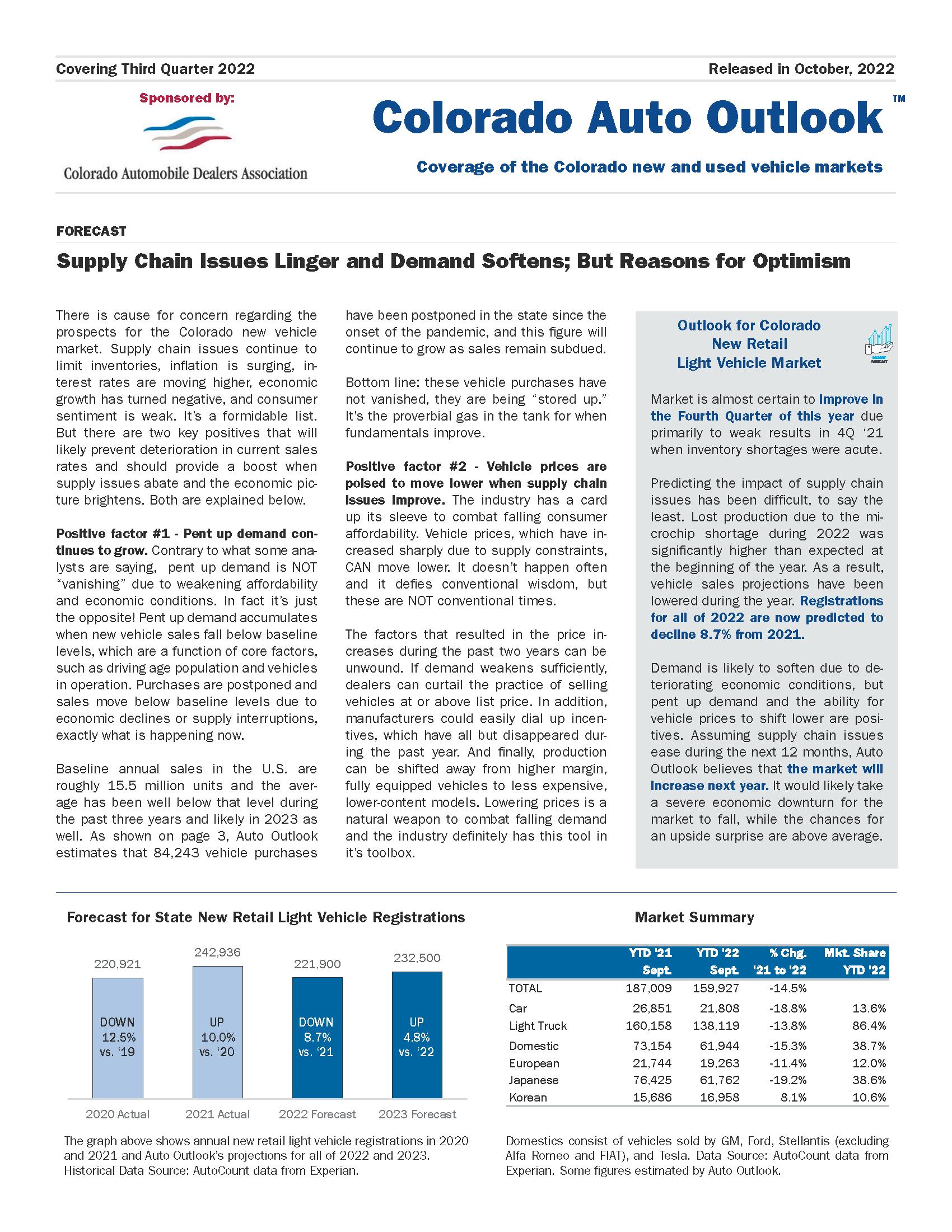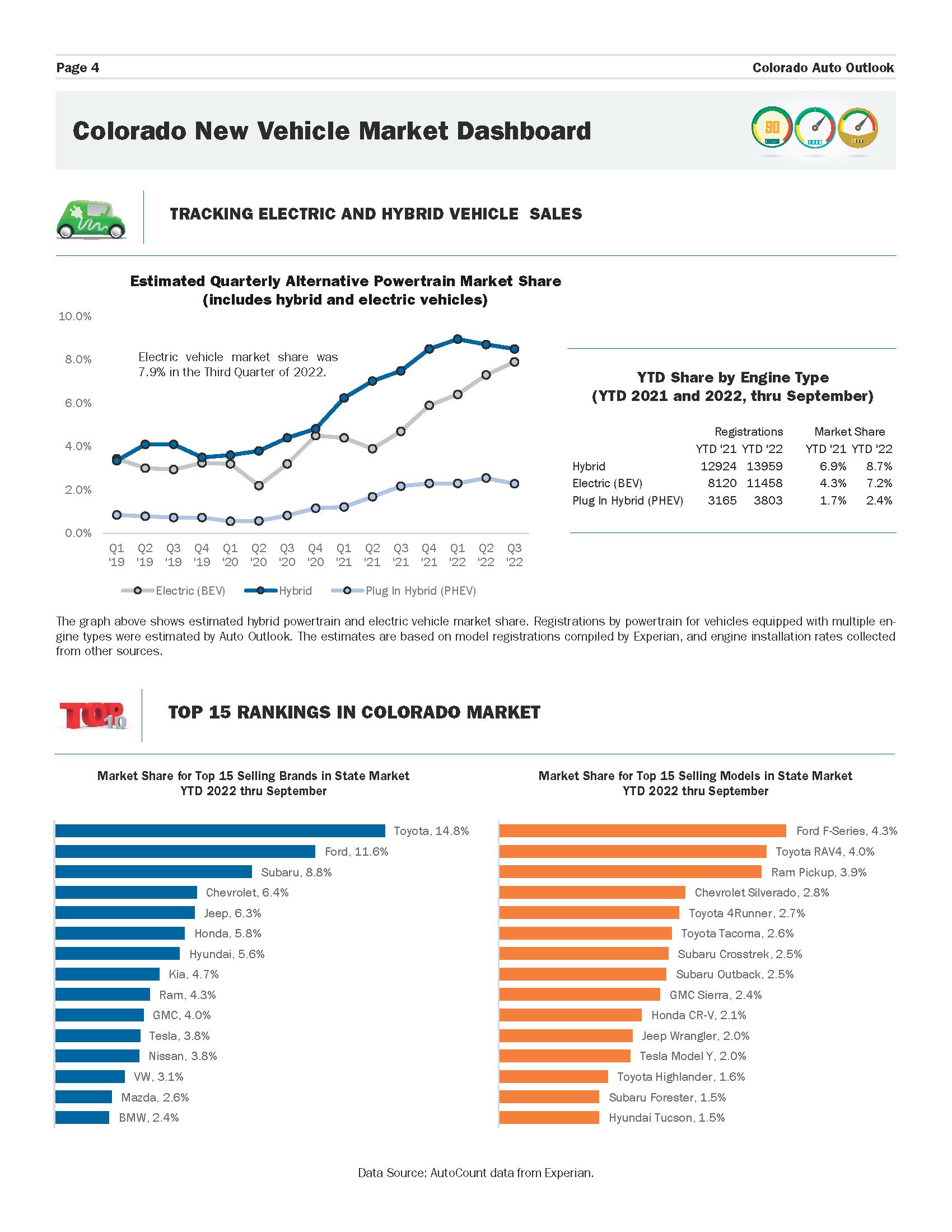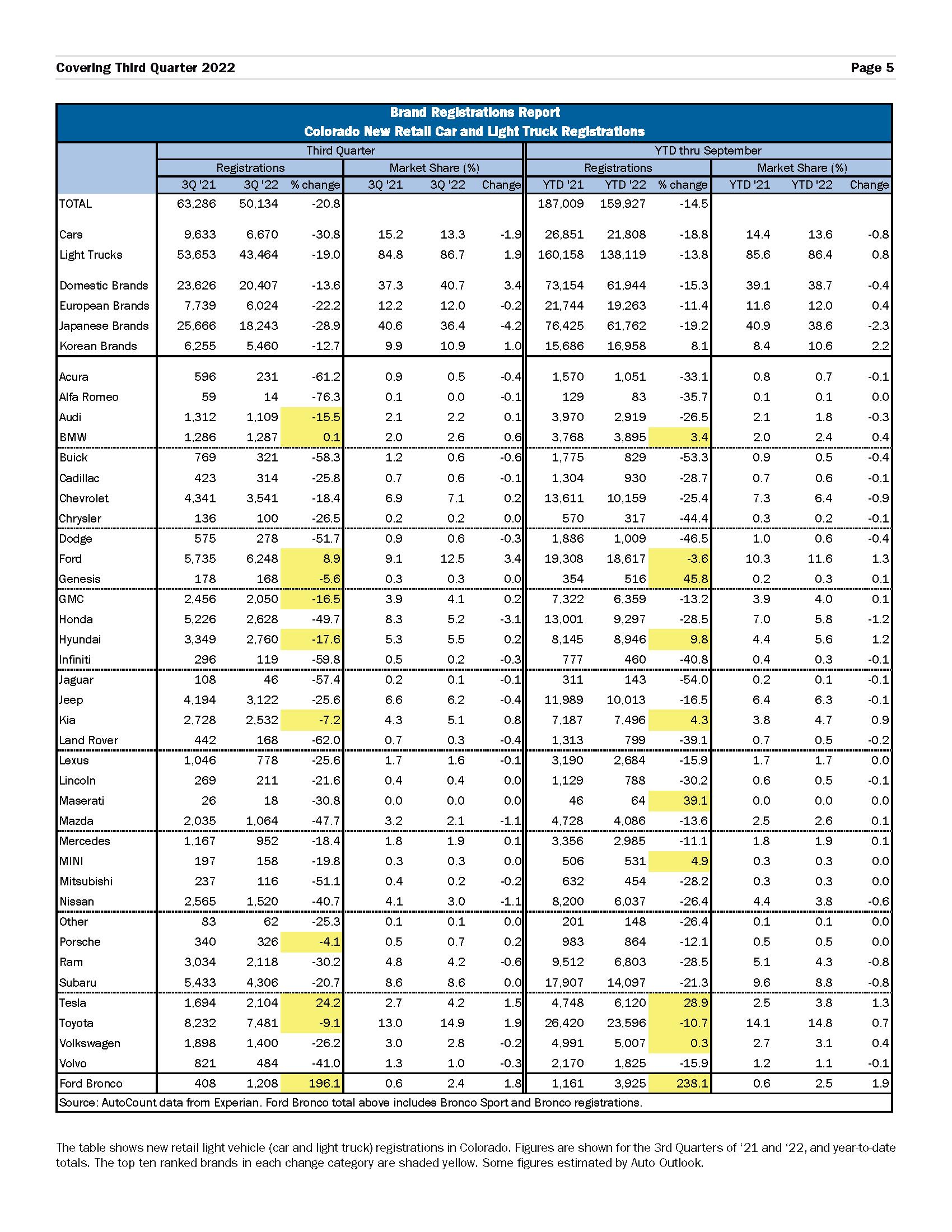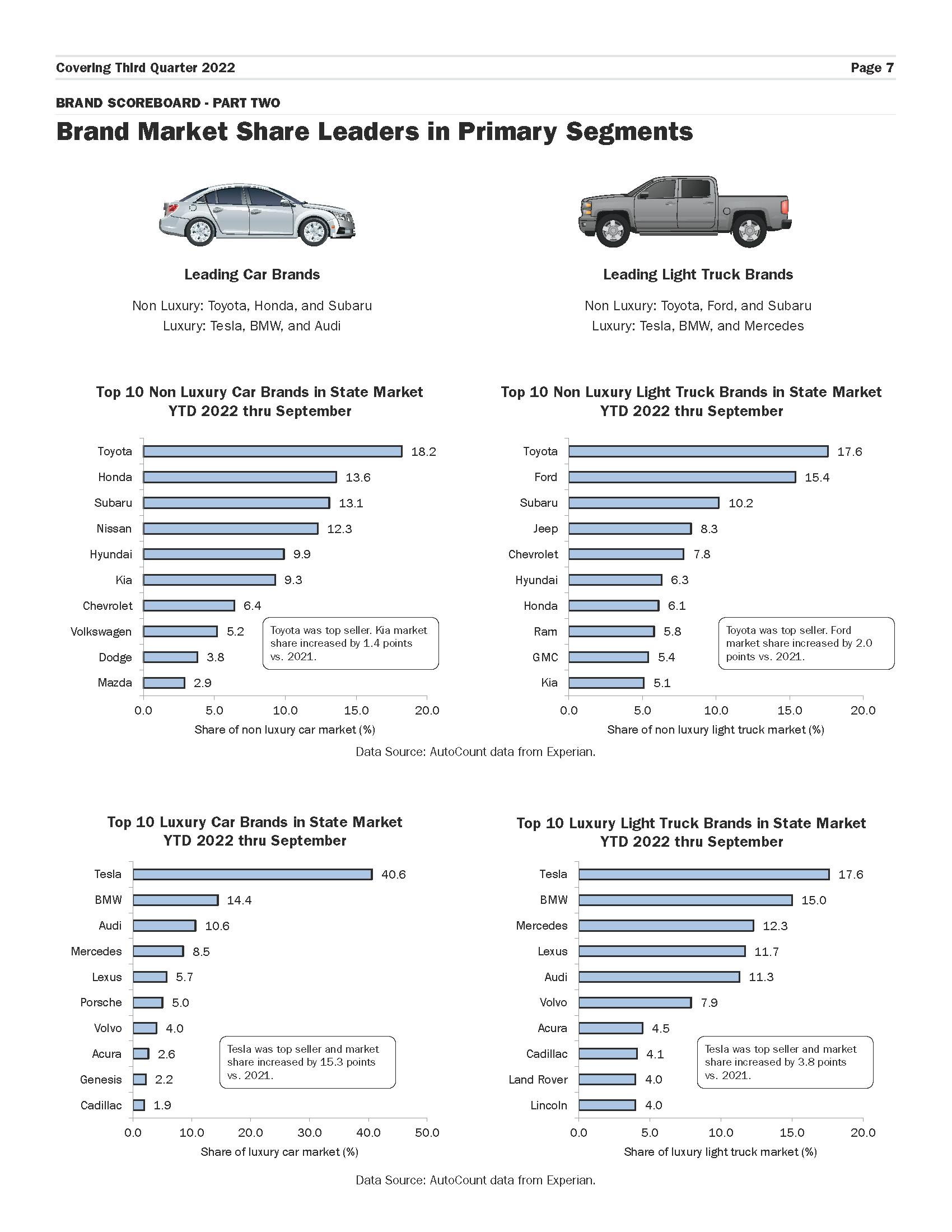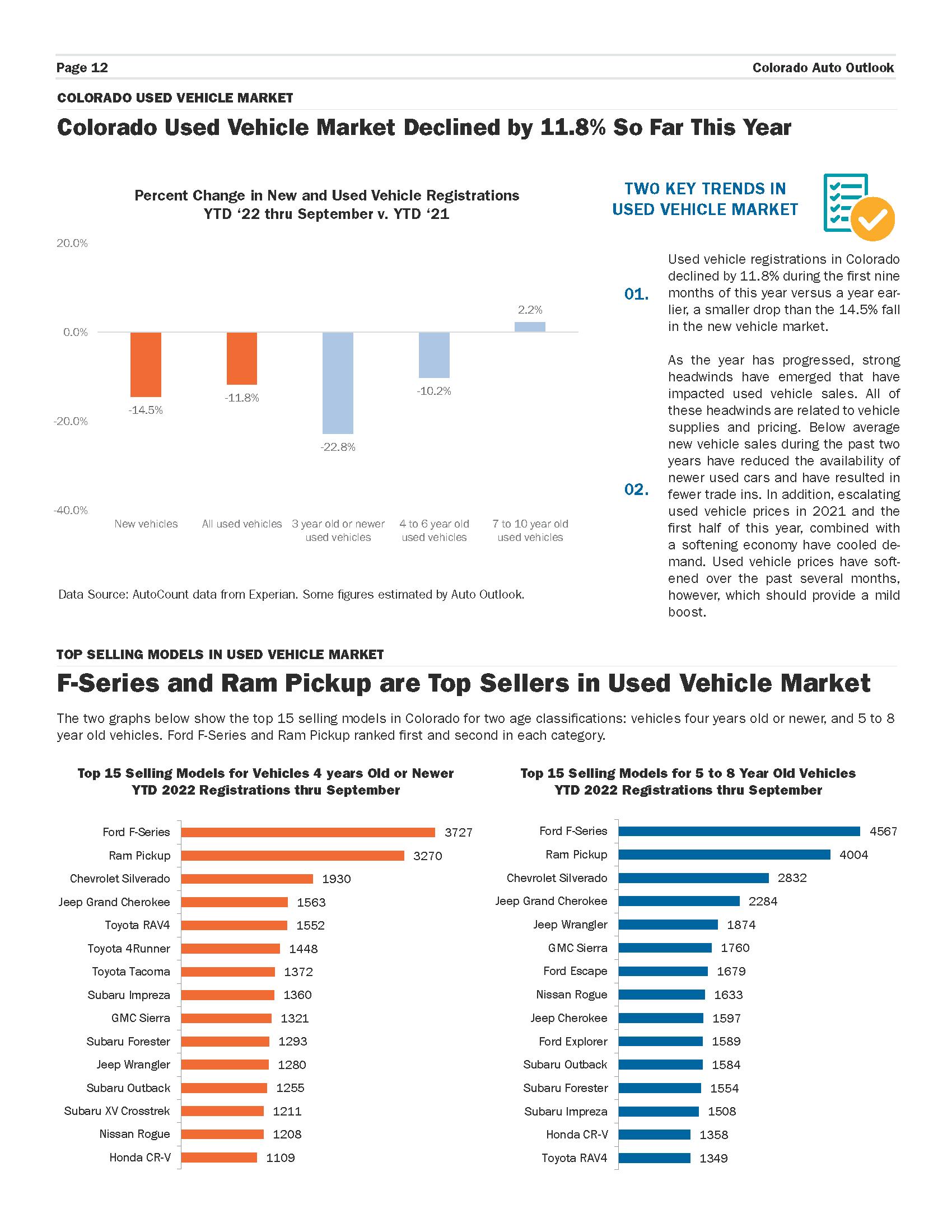




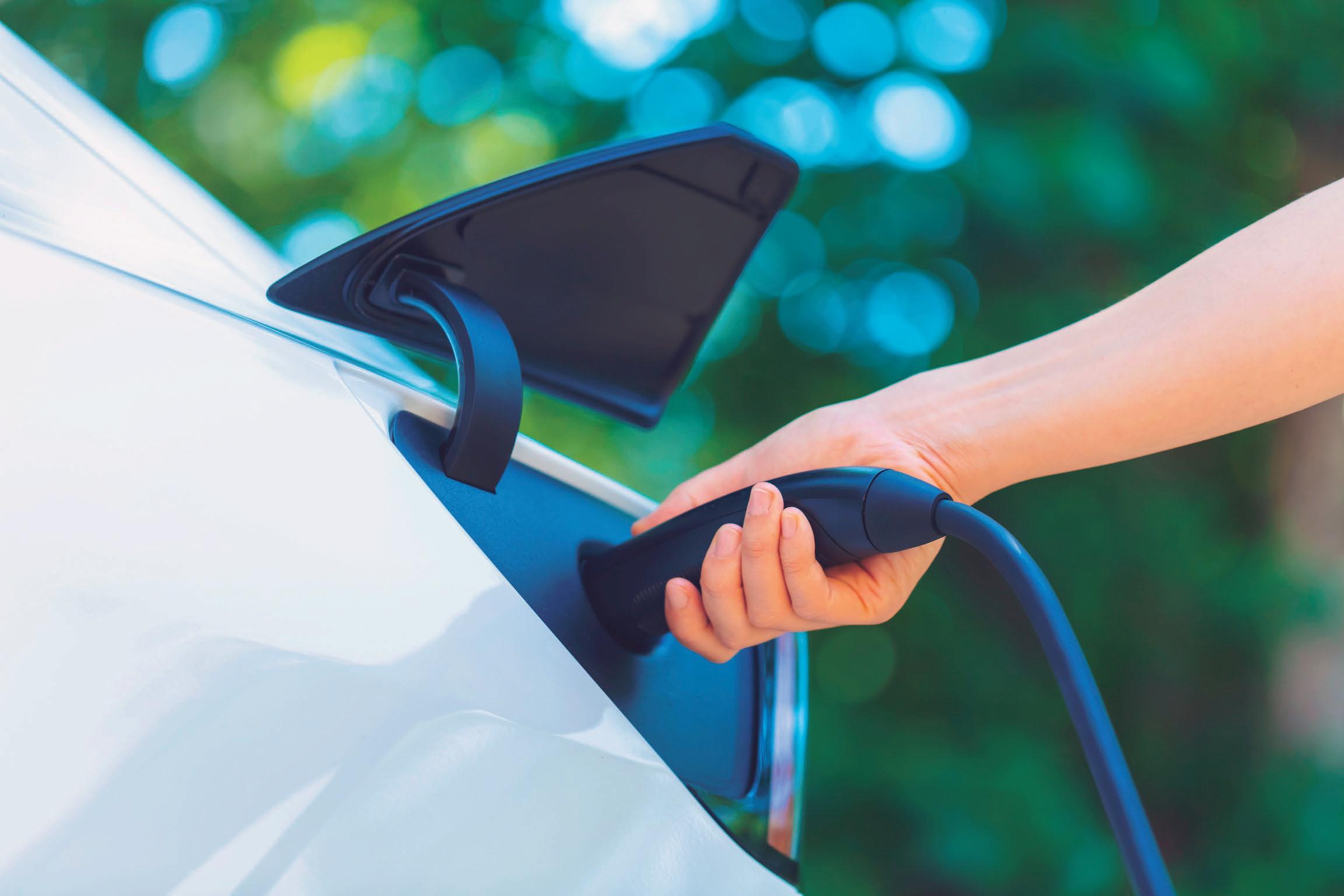













Representing the franchised new car dealers of Colorado
The Colorado Automobile Dealers Association (CADA) is the voice of the automotive retail industry throughout the state. As the automobile dealer trade association, CADA advocates issues of importance to the auto industry in general, Colorado auto dealers in particular and Colorado's driving public.

The Colorado Automobile Dealers Association was formed in 1933 by a small number of dealers to protest a federal excise tax. Building on that success, the association was incorporated five years later.
Today, our dealers range from small, family owned dealerships to nationally owned multiple franchise corporations. CADA represents a united front for each of these new car and truck dealers to local, state and federal public policy makers; the public and the media.
Colorado Automobile Dealers Association
290 East Speer Blvd Denver, CO 80203 303 831 1722 info@colorado auto www colorado auto
Tim Jackson, CAE, CMP President & CEO tim jackson@colorado auto 303 282 1448
Marsha Temple Chief Operating Officer marsha temple@colorado auto 303 457 5123
Matthew Groves
Vice President of Legal, Regulatory & Compliance matthew groves@colorado auto 303 282 1449
Beth Weir Controller beth.weir@colorado.auto 303.457.5120
Kim Jackson Marketing & Communications Director kim jackson@colorado auto 303 457 5115
Mark Zeigler
Clear The Air Foundation Director mark zeigler@colorado auto 303 457 5105
Khorrie Luther Business Manager khorrie luther@colorado auto 303 457 5122
Qiana Emery
Member Services Coordinator qiana emery@colorado auto 303 831 1722

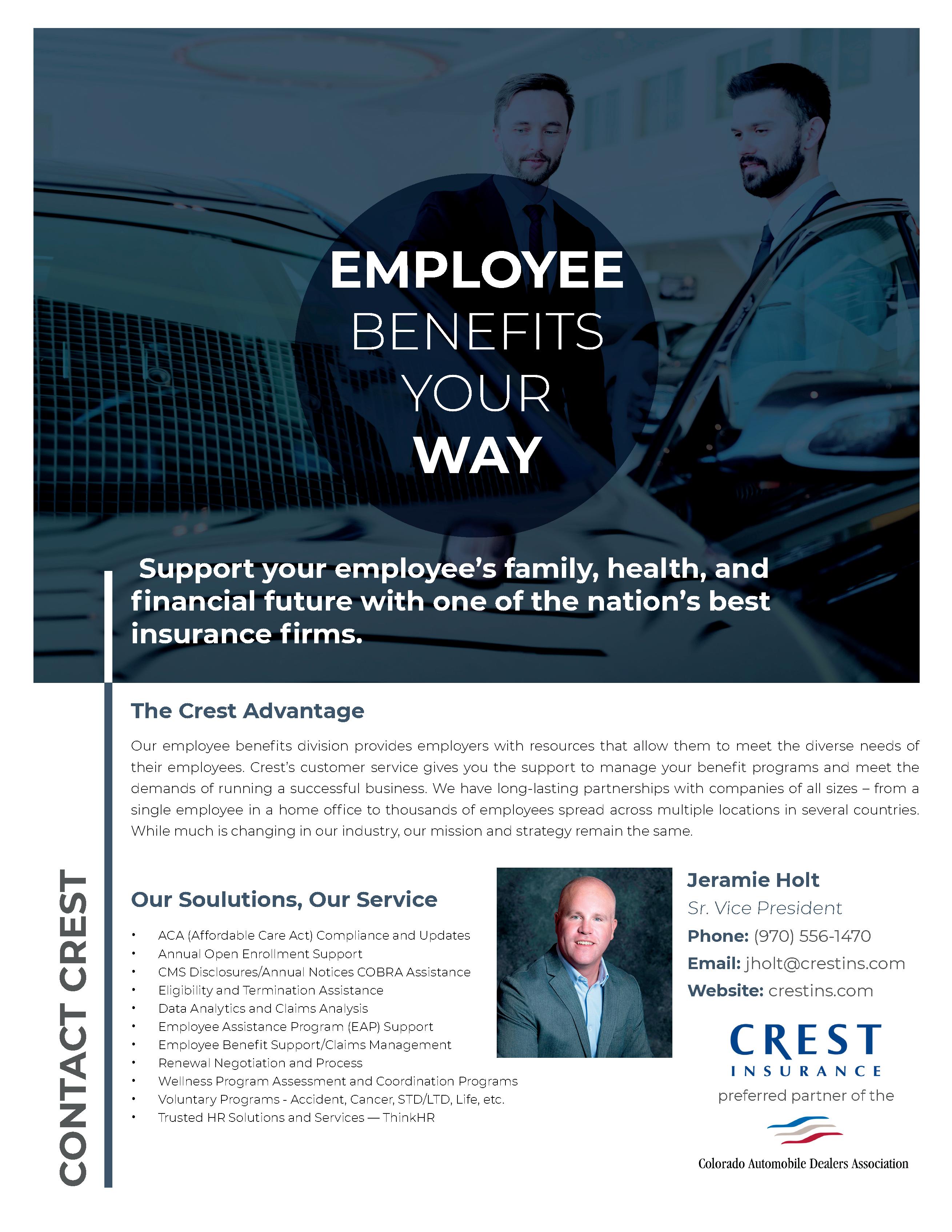 Endorsed Provider of the
Brent Wood 2022 CADA Chair
Endorsed Provider of the
Brent Wood 2022 CADA Chair



As we wrap up 2022, inflation is a key issue for both Colorado’s new car dealers as well as consumers Piled onto higher interest rates, chip shortages, and other supply chain problems impacting inventories, you could almost say we ’ re experiencing the auto industry version of The Perfect Storm
Pundits debate over whether a recession has already begun or if one is just looming I believe we ’ re there spurred by higher interest rates. Plus, the Federal Reserve Bank is signaling another bump is likely at their next meeting. It’s a forced recession caused by a government trying to slow/stop inflation. Once the objective is achieved, how long will it take to climb out of the hole? Most trends in this business take at least 90 days to reverse
The impact is apparent. The average consumer can’t buy a new car without paying more than $700 per month. I’ve heard that around 20% of new car payments are over $1,000. Since Coloradans favor pickup trucks and SUVs over cars by about 85% the higher figure is closer to reality.
This is having a huge impact on the lease business. As people end existing leases and try to get into a new vehicle, they’re discovering monthly payments much higher than they were paying If they want to buy their leases out, they face much higher loan rates Imagine driving your vehicle for three years and then finding out that your payment to purchase it is actually a couple hundred dollars more per month Customers waiting on new car orders are dismayed to learn that when vehicles arrive prices have gone up considerably It’s a little like being hit in the face with a bucket of cold water!
We’ve been begging manufacturers for more inventory. You’ve seen the stories about vehicles sitting in parking lots waiting for chips or parts before they can be shipped. Other reports reveal how much it costs to bring them in from overseas. Now we ’ re experiencing new pressures that will hurt Colorado new car dealers and consumers
First, the hurricane in Florida damaged or obliterated more than two million vehicles Manufacturers will be directing new inventory to Florida’s dealers to get them back to operational. Second, inventory is going to big companies with pre existing fleet contracts. For example, when the pandemic hit, rental car companies drastically cut their fleets. With people traveling again, they’re rebuilding. Rental car agencies seem to be receiving the bulk of the inventory being delivered due to the large purchase contracts



CADA is reviewing its finances in the same way dealers are evaluating our expenses and finding ways to control them and scrutinizing every contract and relationship Obviously, with fewer vehicles being sold, dealer dues will go down, impacting the association’s revenue In the last couple of years our top revenue generator, the Denver Auto Show, has been canceled, reinvented and its current future is continually being discussed. Our support for the Clear the Air Foundation has shifted away from donated vehicles to fundraisers like the very successful CADA Annual Member Golf Event and Colorado Automotive Hall of Fame dinner
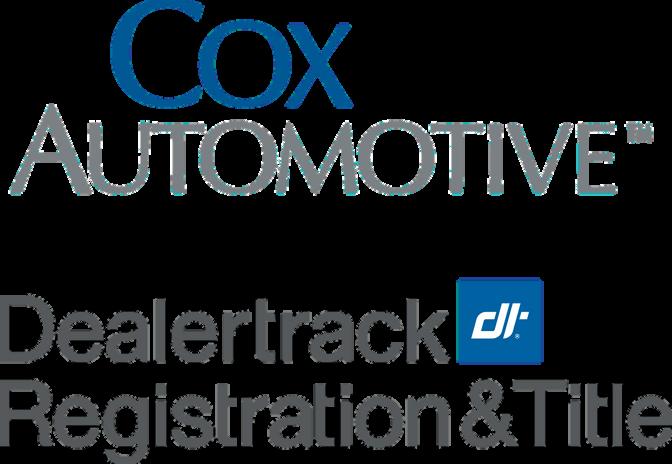
There are a couple of bright spots. Parts and service businesses are robust because people are maintaining their vehicles instead of buying new ones. And with fewer units on our lots, dealers are paying less on floor plans, although as inventory grows, those savings will dwindle
In challenging times, dealers find ways to survive and thrive We do it for our businesses and we’ll do it for CADA It’s important to note that the association’s success rests on having an involved Board of Directors and engaged membership CADA’s board has a great mixture of new and mid generation members providing an impressive blend of energy to confront our challenges I hope members will keep looking outside their own businesses to stay informed and involved both with CADA and politically.

 Tim Jackson CADA President & CEO
Tim Jackson CADA President & CEO


(Niwot) and Broomfield meetings Thank you to all who came out and joined us for the 2022 Regional Meetings!

Regional Meetings is a very A to know what’s on the ur membership. I want to we heard with you, and also how that will influence the w that there’s still a lot of how retail warranty olding CADA will go back to n 2023 to fine tune the rules e Jankowski, the managing ndorsed Provider Armatus the plan changes we are will give Colorado the best e U S regarding warranty ation picking up speed (pun ) rom both Ford and General Motors dealers about the changes they’re

planning to accommodate the shift toward EVs It was a pleasant surprise to hear mostly positive feedback regarding plans to address factory expectations Most dealers we ’ ve heard from say they’re planning to invest more in their dealerships to meet the new requirements CADA will be monitoring the situation to see if franchise agreements need to be modified accordingly going forward.
It comes as no surprise that dealers are having to adjust their pricing models to take into account inflation and the resulting increases in interest rates mandated by the Federal Reserve Of course, ongoing inventory issues and price fluctuations in the value of used cars factors into this, but dealership profitability seems to be pretty solid, even accounting for these influences If the economy slows appreciably that could change, but for now things are looking pretty good
supply, and expensive, almost everywhere in the state At our meeting in Wray, dealers from the Yuma area told us about a developer planning 200 new homes There was little doubt they’d be snapped up, many by people leaving Denver for rural Colorado It was quite eye opening
Inventory levels remain low for most dealers, and incoming loads of vehicles are mostly comprised of presold units One dealer told me he recently had 40 cars delivered over two days, and every single one of them was presold He just had to get them detailed and ready for delivery
Technicians are still in short supply. We heard this refrain from many dealers attending the Regional Meetings. One unexpected contributor to the shortage is housing, which is in short



I mentioned that we’d hosted several LGMs while we were on the road for Regional Meetings The LGMs will accelerate as we ramp up for the 2023 legislative session We’ll have several new legislators who we’ll want to educate about the importance of the automotive industry to Colorado’s economy, and why having a strong network of franchised dealers is critical. Please make sure that you participate when possible. The message is always more compelling when it comes from dealers themselves, not just me and others on CADA’s staff
We’ll be fine tuning our year end meeting Insight 2023 scheduled for December 7th, so watch for details on the time and place for that You won’t want to miss it
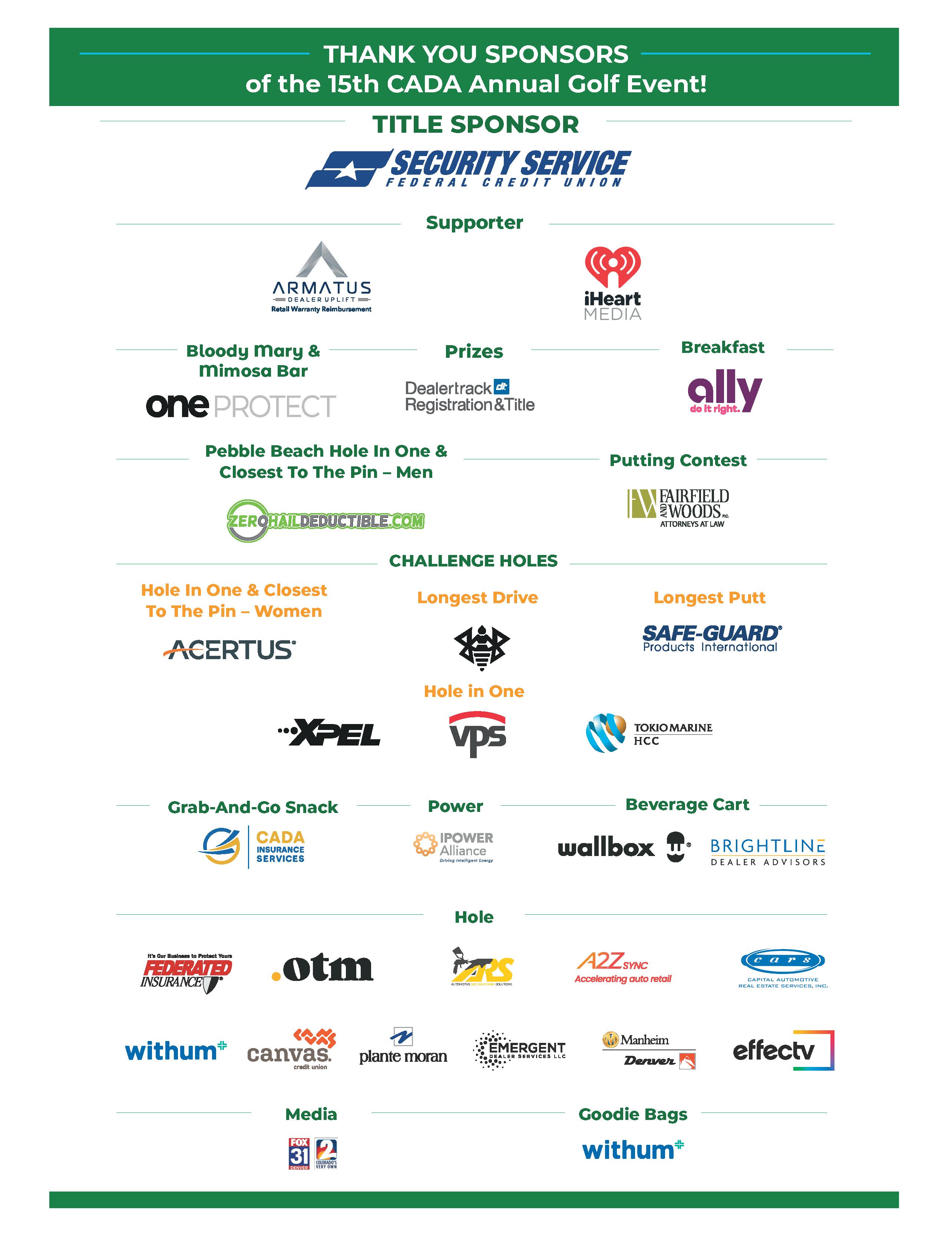



It was a pleasure to see so many of you at this year ’ s Annual Member Golf Event! We were thrilled that over 142 people joined us for an unforgettable day on the green. The weather was perfect with sunshine all day long, but the connections and conversation were the real selling point
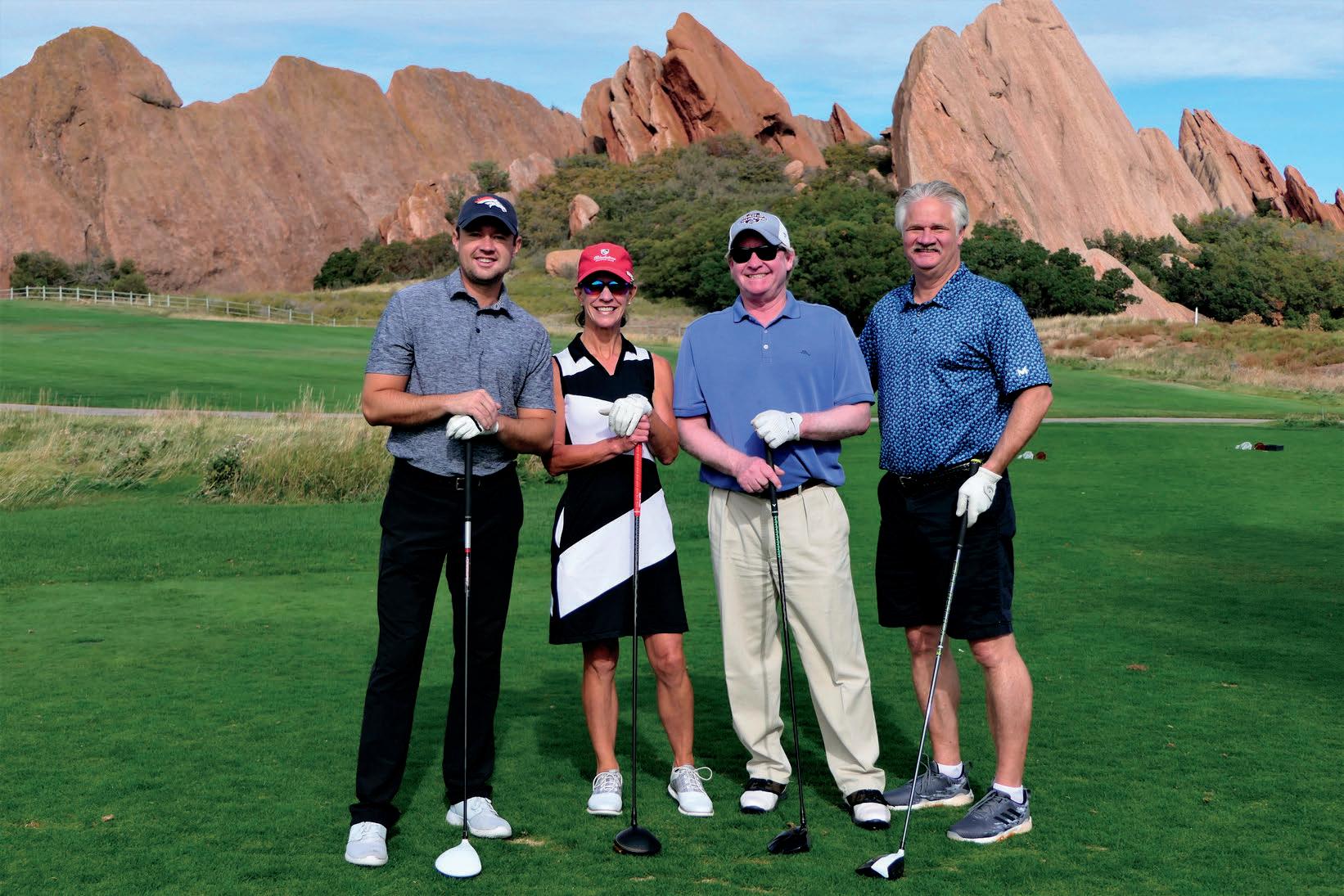

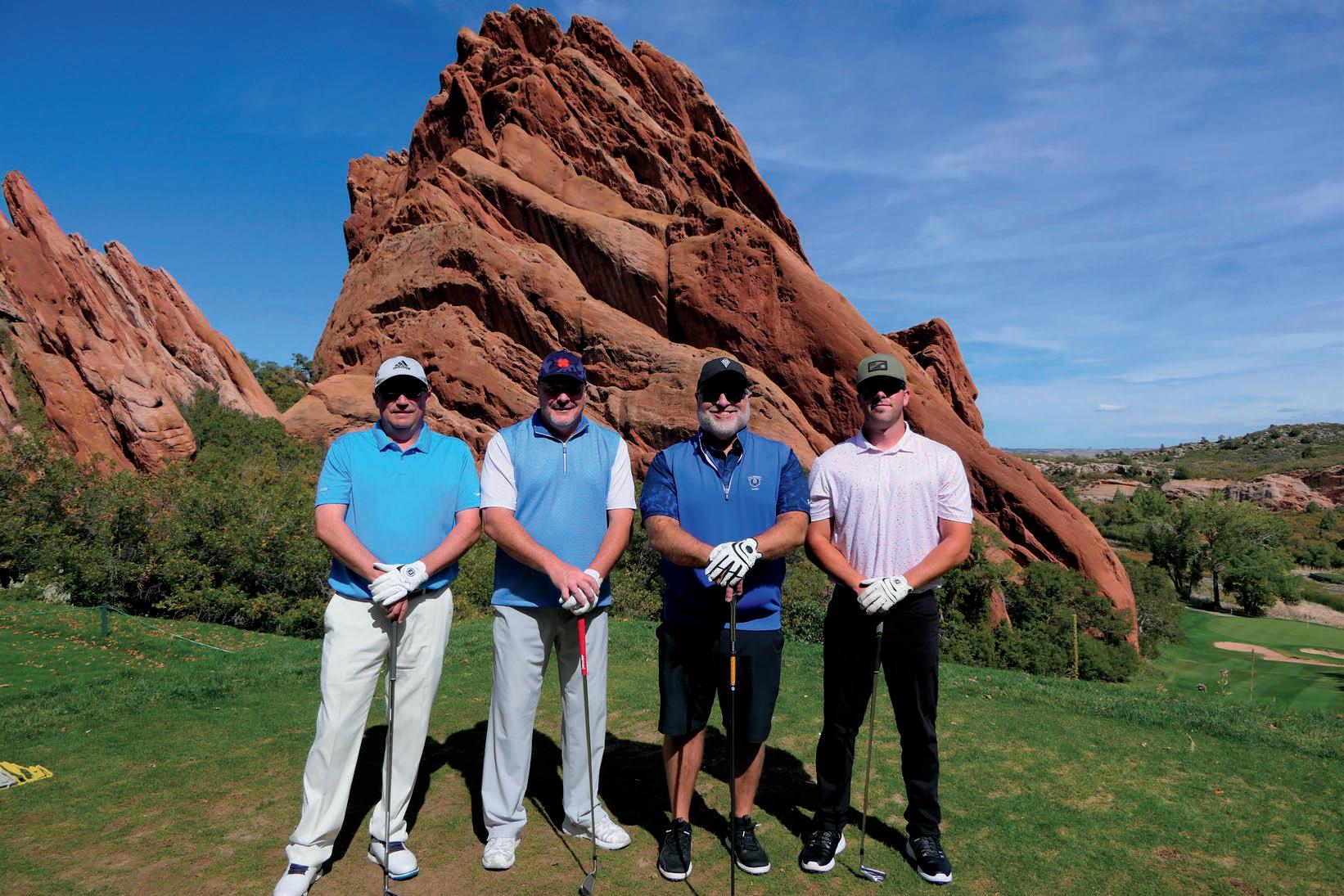

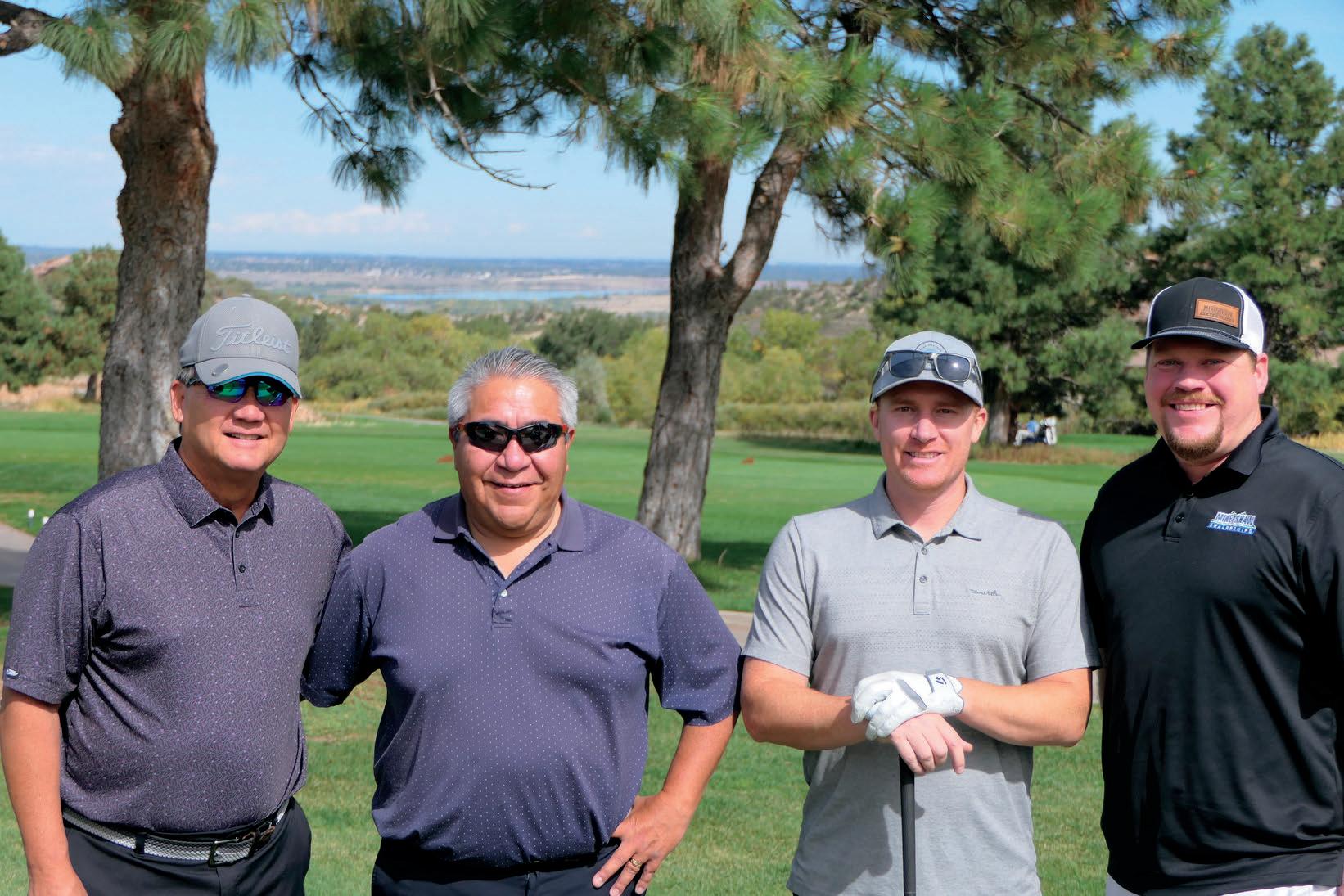
Thanks to our generous sponsors, proceeds from this event help deserving students pursue their dreams in automotive technology education The revenue generated from this event is still being finalized, but we expect proceeds will provide an additional $25,000 for our auto tech scholarship program
Thank you to everyone who attended, sponsored or donated prizes We couldn’t have done it without you! And a very special thank you goes out to our amazing staff members who helped make sure this event was off without a hitch.
We hope everyone had a wonderful time and we can’t wait to see you all again next year! Remember to register early it will likely sell out again!
Mark Zeigler Clear The Air Foundation DirectorMike Maroone Chevrolet South Dellenbach Motors
The Faricy Boys Ford
Pueblo Dodge Chrysler Jeep Ram Pueblo Toyota O'Meara Buick GMC
The Faricy Boys Hellman Motor Company O'Meara Ford
AutoNation Chrysler Jeep Arapahoe Mountain States Toyota BMW of Loveland
Perkins Motors Johnson Auto Plaza Stevinson Toyota West Faricy Boys Automotive Salida
Phil Long Ford of Chapel Hill Schomp Honda Schomp Hyundai Stevinson Toyota East Mike Maroone Honda
O'Meara Volkswagen Phil Long Honda of Glenwood Springs
Phil Long Hyundai of Chapel Hills
Phil Long Valucar Schomp Nissan Schomp Subaru AutoNation Chrysler Jeep Broadway
Emich Volkswagen Emich Volkswagen of Boulder Foundation Chevrolet Freeway Ford Honda of Greeley
Markley Motors
Mile High Honda
Peak Kia North Schomp Ford Schomp Mazda Shortline Buick GMC Berthod Motors
Castle Rock Ford
Dave Solon Nissan Elway Chevrolet Emich Chevrolet Fisher Honda Foundation Hyundai of Boulder Foundation Kia
Fuoco Honda Hyundai of Greeley
King Chevrolet Buick GMC Longmont
Mike Maroone Ford of Longmont
Phil Long Ford of Denver
Phil Long Glenwood Springs Subaru Phil Long Lincoln Planet Honda Schomp BMW
9 8 3 20
4 3 3 3 2 2 1 18
12 7 4 23
4 3 3 3 1 1 1 16
O'Meara Buick GMC O'Meara Ford O'Meara Volkswagen O'MEARA TOTAL
Schomp Honda Schomp Hyundai Schomp Nissan Schomp Subaru Schomp Ford Schomp Mazda Schomp BMW SCHOMP TOTAL
The Faricy Boys Ford The Faricy Boys Faricy Boys Automotive Salida FARICY TOTAL
Phil Long Ford of Chapel Hills Phil Long Honda of Glenwood Springs Phil Long Hyundai of Chapel Hills Phil Long Valucar Motor City Phil Long Ford of Denver Phil Long Glenwood Springs Subaru Phil Long Lincoln PHIL LONG TOTAL
3 1 20
2 9
Foundation Chevrolet Cadillac Foundation Kia Castle Rock Ford Foundation Hyundai of Boulder

AutoNation Chrysler Jeep Arapahoe AutoNation Chrysler Jeep Broadway AUTONATION TOTAL 2 1 1 1 5
4 3 7
FOUNDATION TOTAL Stevinson Toyota West Stevinson Toyota East STEVINSON TOTAL
2 2 1 5 Planet Honda PLANET TOTAL 1 1
Emich Volkswagen Emich Volkswagen of Boulder
Mike Maroone Chevrolet South Mike Maroone Honda Mike Maroone Ford Longmont MIKE MAROONE TOTAL



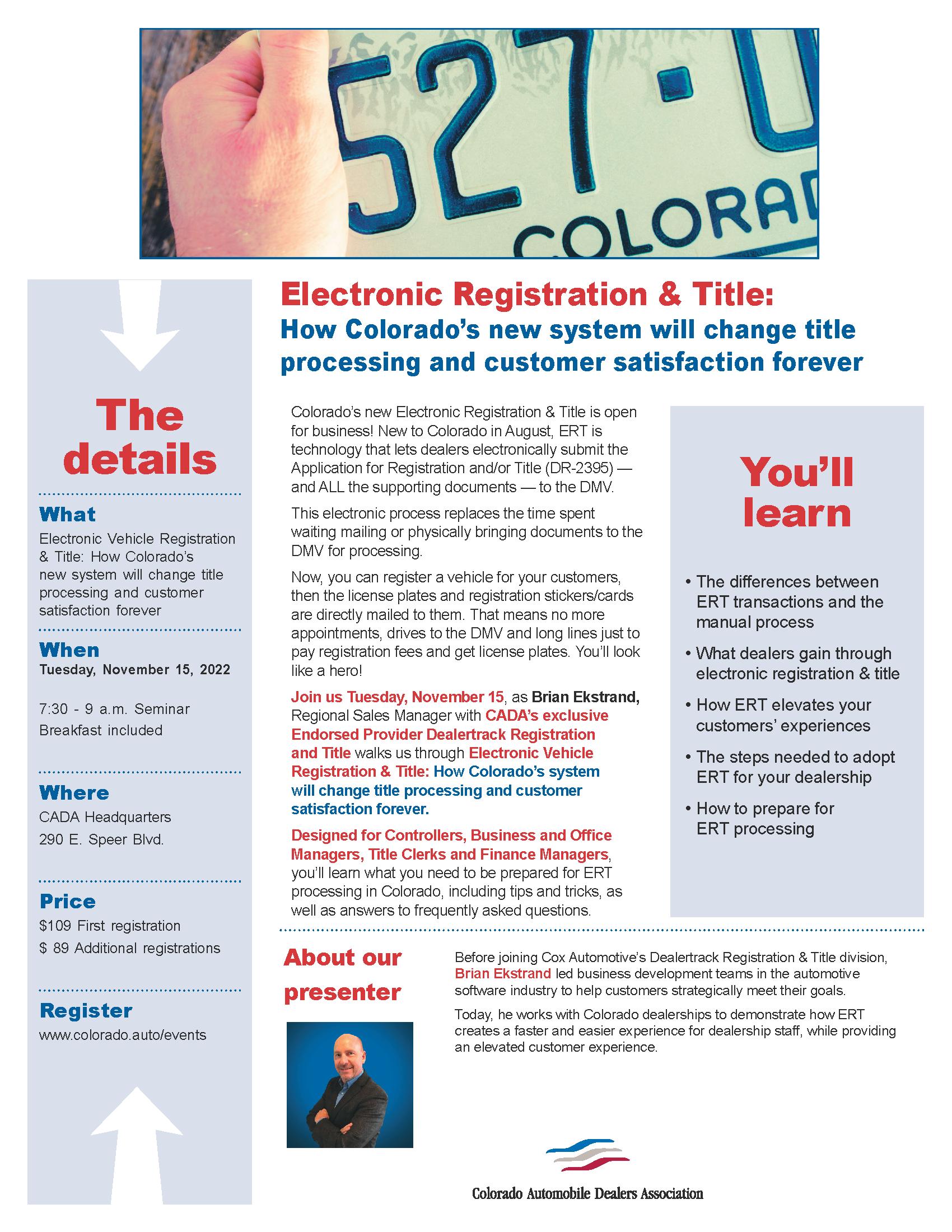
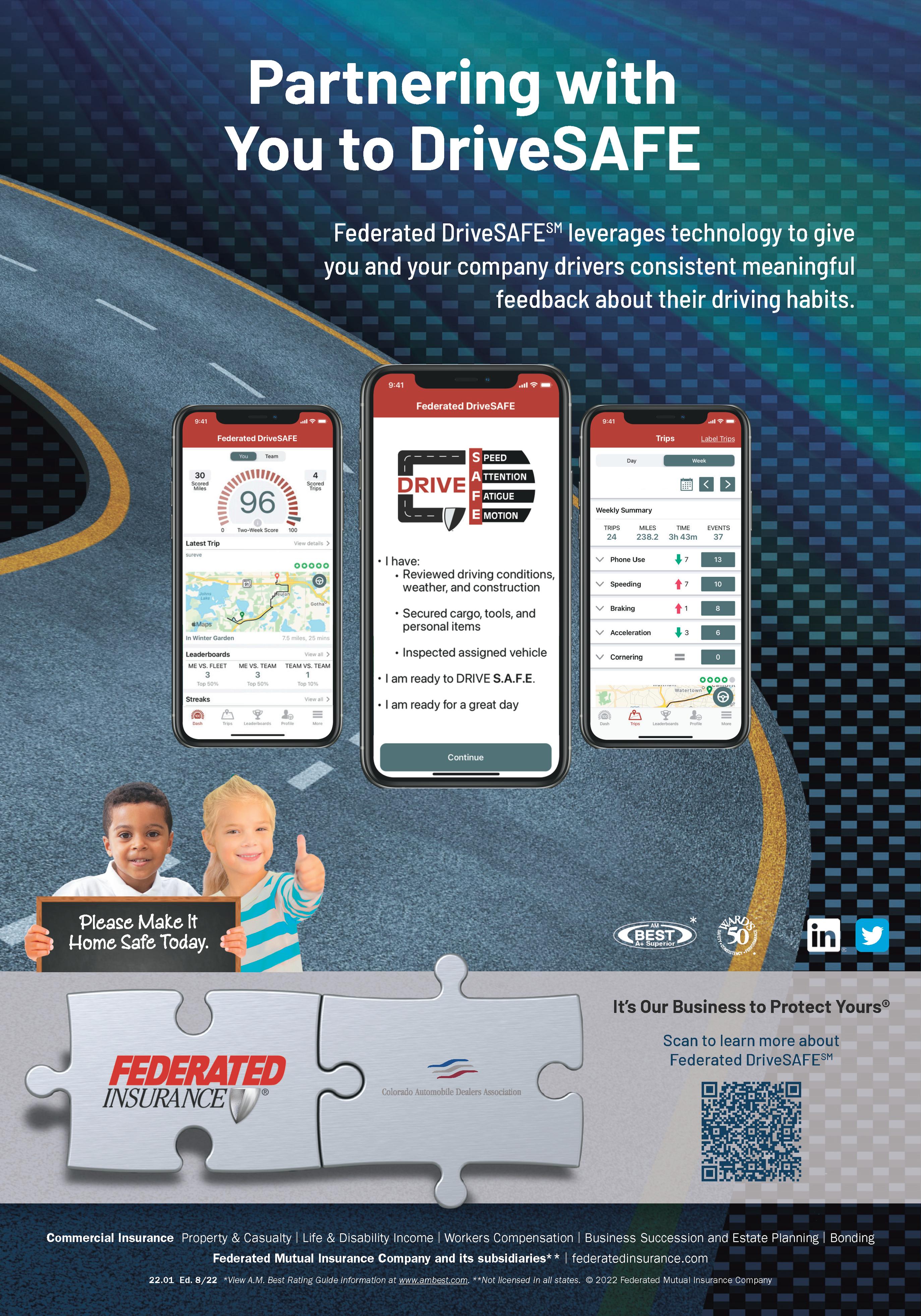

It’s no secret that employee benefits can help attract and retain employees, but does that still hold up during a Great Resignation? With 33 million Americans leaving their jobs in 20211, employers are struggling to keep top talent This mass exodus of the Great Resignation has created a job seeker’s dream market right now, where jobs are plentiful, and recruits have the upper hand when negotiating salary, benefits, and other perks. So, what can you do to overcome employee shortages and maintain a competitive edge?

It’s natural to feel like you ’ re fighting against impossible odds, but there are ways to help move things back in your favor Consider implementing incentives specific to bus drivers The more tailored they are to the type of people you ’ re hiring, the better chance you may have at attracting them.
You might see an increase in applicants if you ’ re able to provide a GPS navigation system or an iPad with access to GPS in
vehicles to help drivers feel comfortable with the routes Helping them find ways to avoid heavy traffic or find the fastest route could prove to be very valuable not only to them, but also to you and your students
No matter your budget, there are likely ways to offer some sort of bonus You could consider attendance based bonuses that incentivize drivers to be more available and reliable, or a referral bonus if they help bring in more great employees Consider paying drivers a monthly or quarterly lump sum based on the number of days they drove
While some of the previous incentives could also apply here, there are more specific options for substitute teachers to consider
With budgets already tight, even the smallest increases could prove to be extremely valuable. If you ’ re paying $125 but the district

That old saying, “Don’t Californicate Colorado,” is taking on new meaning in the battle over transportation’s future in our state. That’s because where California goes on cars, Colorado has followed But since the California Air Resources Board (CARB) voted in late August to ban the sale of internal combustion engine vehicles starting in 2035, Colorado’s lawmakers and regulators have a decision to make: Will or won’t Colorado go along with California this time?
California’s new regulation does not prevent people from holding on to their Internal Combustion Engine (ICE) vehicles, and used ICE vehicles will continue to be available A carve out for plug in hybrid vehicles (PHEVs) allows manufacturers to include 20% of them in total sales by 2035. But over time, PHEVs would be phased out, too. By 2026, the California timeline calls for 35% of new vehicles sold to be battery electric or hydrogen fuel cell powered, bumping up to 68% by 2030
Overall, there were about 47,000 electric vehicles registered in Colorado last year It will take a massive acceptance by the public to reach almost a million EVs by 2030, the number projected by state planners, who believe that enough battery improvements will be made by 2025 to make the cost of EVs comparable to ICE vehicles.
California was first to set a tailpipe emission standard in 1966 and has been allowed to set its own, more stringent emissions standards since the early ‘70s under a federal waiver to the Clean Air Act Because of California’s population and consumer market size it has had an outsized impact on what automakers build and sell nationwide
Colorado is one of 17 states adopting California’s previous Zero Emission Vehicle standards in an attempt to curb air pollution and climate change Following the new California ban on ICE cars would continue that movement, and in a state where the Environmental Protection Agency already has said air pollution mainly ozone is at critical levels, it almost certainly will be looked at carefully

According to the latest news reports, Gov Jared Polis, who has pushed hard for electric vehicles, is signaling Colorado might not adopt the California ban The Colorado Energy Office has issued this statement: “While the governor shares the goal of rapidly moving towards electric vehicles, he is skeptical about requiring 100% of cars sold to be electric by a certain date, as technology is rapidly changing ”
Californians led on embracing zero emission vehicles: 16% of new cars sold this year, an acceleration from 12 41% last year and 7 78% in 2020 While Coloradans’ interest in electric vehicles is accelerating, sales are still small compared to ICE vehicles A Colorado Sun report in April pegged EV and PHEV sales for the first quarter at 8.6% of the total, compared to 5.6% in the first quarter of 2021. That’s much behind California but also Oregon (9.4% of total sales), Washington (10.7%) and Hawaii (10%).

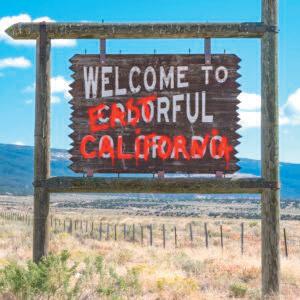
The governor ’ s statement mirrors some of the things that Colorado’s new car dealers have been saying for some time:
New ICE cars are 99% cleaner than they were just a few years ago.
Older, high emitting cars are the biggest culprits for emitting greenhouse gases in Colorado.
Even newer and less polluting automotive technologies are in development that could make electric vehicle technology obsolete, e g , hydrogen fuel cells
EV manufacturing costs are still too high to make EVs affordable for consumers and profitable for automakers
Electric charging infrastructure doesn’t yet support a rapid increase in EVs although Colorado will get $57 million from the federal infrastructure bill to build out its charging network
California’s climate is radically different from Colorado’s so California standards are not appropriate
from the sale of recycled donated vehicles, most of which came from CADA members Proceeds have been used to offer scholarships to students who are studying to become automotive technicians
Colorado adopted California style Low Emission Vehicle (LEV) standards in November 2018. At the time, CADA President Tim Jackson estimated that the LEV standards would add an average of more than $2,000 to the sticker price of a new car. CADA’s lawsuit to prevent the LEV standards from going into effect was thrown out with the judge saying CADA didn’t have standing to oppose the new standards. The ruling never addressed the merits of the case.

CADA recognized the need to clean up Colorado’s air long ago. The CADA Board of Directors funded the launch of the Clear the Air Foundation in 2007. Its purpose was to get older, high emitting vehicles off the road. Most of the subsequent funding came
In March 2019, CADA and several other business and industry organizations formed the Freedom to Drive Coalition, aimed at opposing state and local regulations that focused on “limiting the rights of motorists and commuters,” and supporting “ consumers right to choose the vehicles that are best for them” while opposing “efforts that cede regulatory authority to an out of state commission with no accountability to Colorado.” In other words, Colorado shouldn’t be tied to standards set by California’s Air Resources Board.
Following an executive order from Gov John Hickenlooper, Colorado’s Air Quality Control Commission adopted Regulation 20, California’s Low Emission Vehicle standard in November 2018 Then in August 2019, following an order from Gov Jared Polis to boost the number of EVs, it authorized the California Zero Emission Vehicle (ZEV) standard, mandating that at least 5% of the vehicles for sale here by 2023 had to be electric, increasing to 6% by 2025
CADA’s incoming 2020 Chairman Jeremy Hamm said, “This industry can help solve its problems Coloradans don’t need people who don’t understand who we are creating and not solving problems We should be making local decisions instead of letting an unelected board in California make decisions that affect Colorado.”
The AQCC’s adoption of ZEV standards had the effect in Colorado of circumventing the Trump administration’s action in September 2019 to revoke California’s longstanding ability to set its own standards. California and 23 other states sued. The lawsuit was stayed when the Biden administration directed the EPA to reconsider the waiver’s revocation.
Roadmap, which it called, “the most action oriented, ambitious and substantive planning process Colorado has ever undertaken on climate leadership, pollution reduction and clean energy transition ” Critics of the plan charged regulators with setting targets and reverse engineering ways to achieve them.

Now Colorado is faced again with the prospect that California’s action to phase out and then ban the sale of ICE vehicles could be adopted here. Expect a vigorous opposition to the attempt to Californicate Colorado.
Continue swift transition away from coal to renewable electricity
Make deep reductions in methane pollution from oil and gas development
Whether the waiver will stand is still a live issue, because in May a group of 17 other states (Alabama, Arkansas, Georgia, Indiana, Kansas, Kentucky, Louisiana, Mississippi, Missouri, Montana, Nebraska, Ohio, Oklahoma, South Carolina, Texas, Utah, and West Virginia) sued the federal government saying that California’s ability to set its own emission standards would have such a dramatic effect on the automotive marketplace that it would have a nationwide impact that in effect would violate “equal sovereignty” of their states
Meanwhile, in Colorado, the war on ICE vehicles continues In January 2021, Colorado’s Energy Office released the Greenhouse Gas Pollution Reduction

Since opening its first dealership in Denver in 2005, Alpine Buick GMC has added two locations one in Colorado Springs in 2018, its flagship location in Littleton in 2020 and Alpine Ford in Pueblo in 2022.
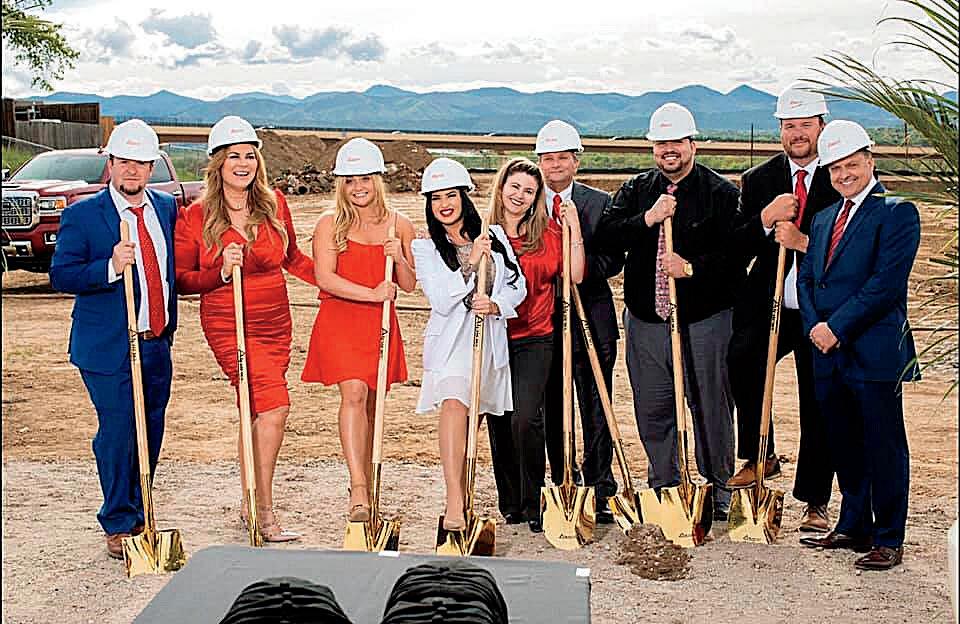

The company is the highest volume Buick GMC dealership in Colorado and the state’s largest woman owned business
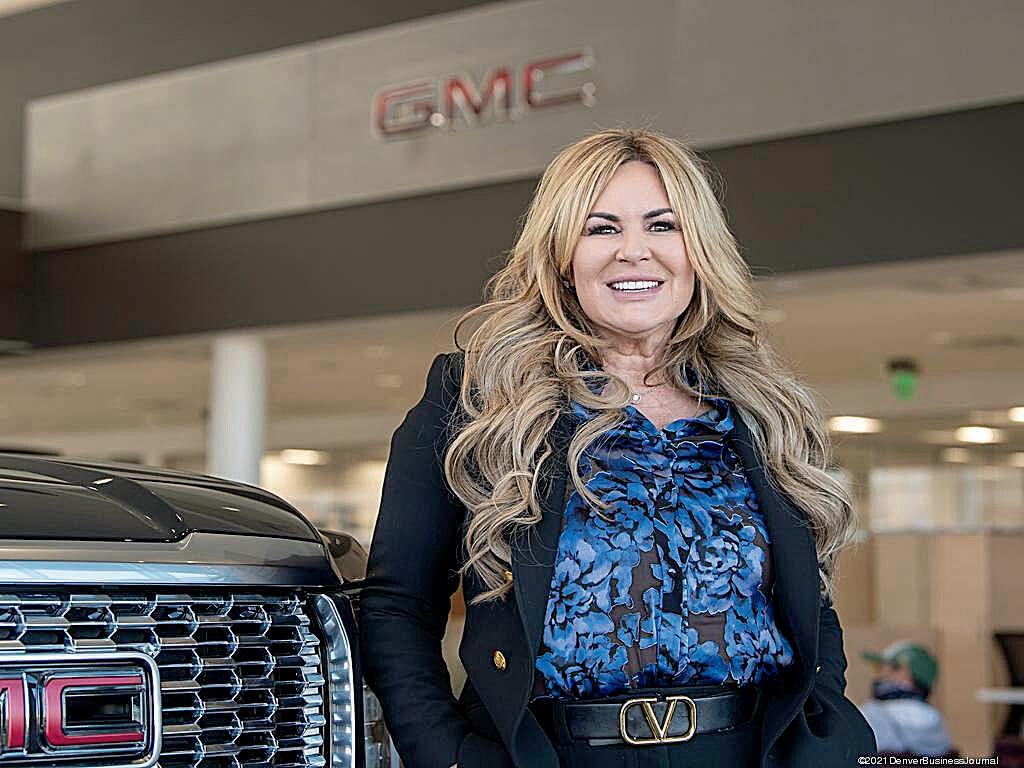
Over the past two years, Alpine Buick GMC has experienced growth despite a difficult automotive market that’s still feeling the effects of the pandemic In the last two years, the Colorado dealerships had a nearly 70% increase in revenue, and Alpine Buick GMC ranks as the No 1 GM dealership in Colorado
The pandemic and resulting supply chain issues made procuring chips for vehicles difficult GM is building cars and parking them until they can be fitted with a chip.
“Alpine alone has more than 100 vehicles that have been built for its inventory that are parked and waiting to be retrofitted,” said Ivette Dominguez, Dealer and President of the Alpine Buick GMC. “To add insult to injury, supply chain disruptions might cause problems with the delivery of cars once they’re ready ”
While its likely that the issues won’t be resolved until late 2022 or early 2023, Alpine remains successful because of its strong relationships in the industry and the community, top notch customer service and savvy sales professionals who find the best deals and vehicles for each person who walks into one of its dealerships
Alpine has supported the community throughout its history. Recently, the company launched a fundraiser to help a customer whose son needed a complicated surgery. It’s helped raise more than $2 million for community and nonprofit organizations, including Alice’s 36 Hours for Kids, Children’s Hospital Colorado Foundation and Denver Metro Chamber of Commerce
CONTINUEDFROMPAGE19
down the road is only paying $100, you have the upper hand. Do some investigating to figure out where you fall, and determine whether a slight increase in pay could help you attract subs.
Like bus drivers, offering bonuses could be helpful in retaining your substitute teachers For example, you can provide bonuses that are specific to providing advanced learning or technical skills
In addition to the suggestions above, consider these options for the rest of your faculty and staff
Offer additional vacation days Adding just one more day to their bank could be enough to make you a better fit for the candidate You could also offer designated parking spots to everyone or just certain employees. No one likes to stress over whether they can find parking. Take that easy win!
A great way to show employees you care is by investing in them and their future. Create an additional bucket of money that’s distributed to their retirement program If budget is a concern, you can do this based on performance goals You can also invest in their education by developing a tuition reimbursement program, or by offering student loan forgiveness (which can vary by state)
It’s difficult to create incentives that don’t impact your bottom line. However, there are ways you can utilize free or low cost resources to give your organization an edge
Is your organization active on social platforms? If so, use them to your advantage. Create a contest for your employees by asking them to share open positions, or one that promotes your culture by asking employees to share what they like best. Rewards are easy too. Just enter everyone who participates for a chance to win a low cost prize (gift cards work great here)
Are there local businesses that operate on part time or seasonal employees? Talk with them about cross promoting open positions on their social platforms
Most people and businesses within a community will do whatever they can to help educators Consider adding to your list of employee incentives by partnering with someone local. Do you have yoga instructors who’d be willing to give a free lesson once a week or once a month? Is the local pet shop open to bringing puppies by for a day to boost morale and promote adoptions?
Create a call for volunteers by letting your community know you need help covering recess or more support during lunch You’ll likely find people who can’t commit to something consistent like bus driving but are willing to show up once a month to help with recess
Traditional benefit options are likely no longer enough to attract and retain top talent, and you ’ re likely not the only organization in your area trying to hire. You’re competing for the same small pool of talent. And with more companies allowing remote work, some organizations are even competing on a national and international level. Give your organization the upper hand by getting creative with the incentives you offer and get on your way to overcoming those staffing shortages

